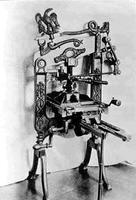Newspapers
NEWSPAPERS in BC are mainly owned by 3 major chains that together operate 17 dailies and more than 100 community papers, claiming a daily readership in excess of 3 million. Dominating the market is Postmedia Network Inc, formerly CanWest Media, publisher of the VANCOUVER SUN and the PROVINCE. At the end of 2005, CanWest's predecessor, Hollinger, sold its remaining papers to a relatively new publishing company, Glacier Ventures International Corp. In 2011 Glacier purchased several of the community newspapers in the Postmedia stable, along with the Victoria TIMES-COLONIST, and smaller market papers in NANAIMO and PORT ALBERNI. Community newspaper markets are dominated by BLACK PRESS LTD which publishes about 100 smaller papers in western Canada. In 2015 Black purchased all of Glacier's papers on Vancouver Island with the exception of the Times-Colonist. At the same time Glacier bought three Lower Mainland suburban papers from Black. VANCOUVER's GEORGIA STRAIGHT is the province's largest alternative newspaper, while 2 national papers, the Globe and Mail and the National Post, also sell into the market. In addition several non-English-language daily newspapers are published in BC, including 3 CHINESE dailies, Sing Tao, Ming Pao and World Journal.
Early History
BC's first newspapers—the Victoria Gazette and Le Courrier de la Nouvelle Calédonie—were established in 1858 to serve the influx of American miners stampeding to the FRASER R during the GOLD RUSH. Both failed before the year was out but were followed by the British Colonist, which has survived as the Times-Colonist. Early papers were partisan and often published to further the political ambitions of their owners or to boost the aspirations of their communities. Amor DE COSMOS used the Colonist to campaign against Gov James DOUGLAS and for responsible government. Douglas attempted to suppress the paper with an obscure British statute that permitted him to require the posting of a bond. He set it as $3,000, an astronomical sum for the day, but Colonist readers raised the money by public subscription. De Cosmos later used his paper to campaign successfully for BC's entry into CONFEDERATION. In 1872 he became the province's second PREMIER. The first newspaper on the mainland was the New Westminster Times in 1860 (see NEW WESTMINSTER). It was supplanted by John ROBSON's British Columbian, another crusader for the "liberalization" of colonial government. Robson, too, later served as premier. In 1884 the Victoria Daily Times was launched. Its LIBERAL PARTY sympathies counterbalanced the CONSERVATIVE PARTY leanings of the Colonist. The Province followed in 1894; it was first published in Victoria, then relocated to Vancouver to take advantage of the boom generated by the Klondike gold rush, and soon it became BC's leading newspaper. Meanwhile, several pioneering editors established papers in the small towns and MINING camps of the Interior, notably "Colonel" Bob LOWERY, John HOUSTON and, later, Margaret "Ma" MURRAY.
As Vancouver surpassed Victoria to become the economic capital of the province, newspaper competition heated up on the mainland. In 1912 Robert CROMIE obtained a moribund Liberal Party newspaper and resurrected it as the Vancouver Sun, one of 5 daily papers in the city. Then markets began to contract. Between 1914 and 1922, 40 daily newspapers folded across Canada. One by one the weaker Vancouver dailies were absorbed by their more vigorous competitors. The Province acquired the premises of the News-Advertiser and the Herald. The Sun took over the World and the Vancouver market became largely a battlefield for these 2 survivors. The Province dominated as the newspaper of record until 1946, when a bitter strike permitted the Sun to capture circulation and pass its rival. By the 1950s the Sun had the largest circulation of any daily paper in western Canada.
Rise of the Chains
Recent newspaper history in BC has been characterized by volatile ownership and increasing corporate concentration. In Victoria the Daily Times and the Daily Colonist were acquired by the Thomson Group (now Thomson Corp) and merged to form the present Times-Colonist, then sold to Southam Inc. In Vancouver Southam and the Cromie family established PACIFIC PRESS (now the Pacific Newspaper Group) in 1957 to print the Sun and the Province. Eventually both papers ended up in Southam's hands and were converted to morning publication. During the 1990s Southam was swallowed by the Hollinger company which in turn sold its major properties to CanWest, later Postmedia, and many of its smaller papers to Glacier Media. The rise of electronic media, which provide instant coverage accompanied by dramatic visual images, and the resurgence of community newspapers serving narrow segments of the market, have forced mass-audience papers to rethink their structure and market positions. Some, like the Province, have begun to publish shorter articles with lively graphic display that emulates television, along with a heavier emphasis on stories related to crime, scandal, entertainment and sports. Others, like the Sun, have tried to provide the depth and context to the news that electronic media can seldom achieve. Most newspapers, from community weeklies to metro dailies, are now exploring news delivery via the Internet.
Throughout their turbulent history, BC's newspapers have produced writers and journalists of national calibre. Among the best known are Bruce HUTCHISON, "Torchy" ANDERSON, Benny Nicholas, B.A. McKELVIE, James K. Nesbitt, Arthur MAYSE, Nancy HODGES, Jim Hume, Pierre BERTON, Mamie Maloney Boggs, Alan FOTHERINGHAM, Pat CARNEY, Marjorie NICHOLS, Barry BROADFOOT and Paul ST PIERRE.
by Stephen Hume
Reading: David Williams Higgins, Tales of a Pioneer Journalist, 1996; Peter Stursberg, Extra! When the Papers had the Only News, 1982; Peter Stursberg, Those Were the Days: The Days of Benny Nicholas and the Lotus Eaters, 1969.


